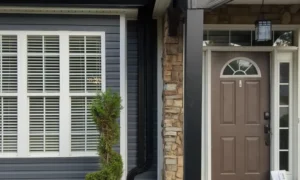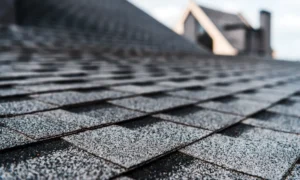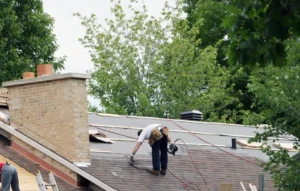
Most everyone knows that spring cleaning is the perfect time to deep clean your house! Dust off the cobb webs of winter and get your home smelling and feeling fresh for the spring and summer months ahead. But remember while you’re inside cleaning, you also have a roof that could use some attention. We recommend spring cleaning for your roof.
Did you know that leaving excessive moss, dirt, and algae can cause damage to your roof, which results in costly repairs? If you can keep up with this portion of home upkeep, you can save yourself some money. That’s a bonus in ur book! Follow along for spring cleaning your roof with Best Roofing.
In case you were not aware, the average roof can last between 20 to 100 years, depending on the material it’s made out of. But the lifespan of your roof can be cut short if installation is inadequate and maintenance is not kept up. Having your roof cleaned every one to two years is a good idea. So, while you’re busy inside spring cleaning, remember to clean your roof as well.
Tools for Spring Cleaning for Your Roof
It is always a best practice to ensure all the tools you need for the spring clean are on hand and ready for use. Here are a few suggested tools you may need for the cleanup.
- A garden hose
- A garden spray nozzle
- Non Corrosive roof cleaner
- Access to a supplemental water pump
- A full-body safety harness
Making Your Roof Last Longer
Making your roof last longer being the goal, roof stains can be a common problem. Improper cleaning leaves black streaks on the shaded areas of your shingles. This is really not a good look for your home, as it can mess up the overall appearance.
Unfortunately, those black streaks on roofs are algae colonies that have formed on the shingles. They feed off of moisture and limestone that is in the very fibers of the shingles.
Good news, if you use shingles that have been treated with an algae chemical, it keeps growth away for about ten years. But once this wears off, your roof could become covered in algae spores. So, pay close attention to your shingles as soon as you spot any algae growth.
Do it Yourself to Save Money
While DIY may seem like a great idea, the bigger the roof, the higher the risk and the cost. If the slope of your roof is too steep and you’re not comfortable working on it, please hire somebody to clean it for you.
Let’s say you are comfortable with cleaning your roof; you will need to start with having a full body harness on for protection, a garden hose that has a garden sprayer attached to it, and a noncorrosive and non-toxic roof cleaning solution. Some stores sell a specific tool applicator and a rinsing tool, but if the stains on your roof aren’t severe, you don’t need to buy these.
Trust us when we say, we are well aware some professional cleaners can charge a large sum for expert cleaning. And, of course, they will repeat this process every few years. It is an extensive and risky job, so be sure to hire a company you believe in, like Best Roofing.
Choosing the Right Cleaning Products
Researching online, you could be convinced to go with what you see the most frequently. All you need is bleach in a pressure washer? No, that is not the case.
We recommend using a garden hose with a light spray setting, so you do not damage your shingles. While, in theory, it seems like a good way to clean, bleach is corrosive and could damage metal roof flashings, your downspouts, and gutters.
Bleach will also lighten the color of your roof and damage anything overspray comes in contact with. Keep in mind that any runoff of bleach from your roof will fall down onto plants below and will most likely kill them. Bleach is also known to kill the top layer of algae and lighten the stains. The key here is it only gets to the top layer and lightens. As an end result, it does not kill the underlying cause; so the algae will grow back right away.
The best products are sodium hydroxide, which is better than bleach and less harmful to any plants around your roof. This product is a little more corrosive, so you will need to wear protective gear.
But in the end, we really recommend looking for a cleaning product that is noncorrosive or non-toxic and is safe for you and the environment.
Pick the Right Day to Prepare Spring Cleaning for the Roof
Picking the right day to clean your roof is just as important as cleaning it. You first want to check the forecast for the weather in your area that day. Once you have figured out the best time weather-wise to clean your roof, prepare the area surrounding your roof by moving any lawn furniture to avoid overspray.
The best time to clean your roof is on an overcast day to keep you and your roof cool and with little to no wind. Hence, the spray gets directly on your shingles, not anyone else’s roof or any surrounding items. These ideal conditions allow the cleaning solution to soak deep down into the algae colonies without evaporating from your roof too quickly.
Before you start cleaning, it is a good idea to blow off your roof with a leaf blower to remove any excess debris like twigs, pine straws, and leaves.
The next thing you want to do is repair any loose shingles or flashings. And while you’re on the roof, clean the gutters and the downspouts so everything from the roof can drain freely.
Cleaning Frequency
We recommend having your roof cleaned at least every two years. But if you live in a region where salt accumulates on your roof regularly, or you live somewhere that is damp, and that has moss and other organisms that constantly grow, you will need to clean your roof more often.
Next, if your roof has trees over it, which produces a lot of shade, you are subject to more bacteria growth and more debris like limbs, sticks, and moss landing on your roof.
If moss seems to be the largest problem for your roof, an expert roof cleaner will install zinc strips to keep moss and other growth away. You see, the zinc strips interact with rainwater and release zinc carbonate. This solution keeps moss from growing around your roof. Fortunately, the strips don’t cost very much, and it’s an easy solution for moss buildup.
If you believe that your roof is subject to these conditions, consider applying a roof coating that will help keep damage at bay. The best way to have this done is for a professional to come out and apply this coating.
Types of Spring Cleaning for Your Roof
There are a few different techniques that roof companies can utilize to clean your roof.
Soft Wash
A soft wash is a way professionals will clean your roof using low water pressure. It’s very similar to your garden hose and has a cleaning solution that removes dirt, moss, and stains. This will be similar to what you could do yourself, but if you’re not comfortable on the roof, the professionals can take care of it.
Low-Pressure Wash
We mentioned before not to use a pressure washer on your roof, but when a professional comes to you and says they are going to use a pressure washer, don’t panic. They will use it on a very low-pressure mode, which is more like a gentle wash but a little bit stronger to remove moss and debris from your roof.
Pressure Wash
When a roofing company indicates they’re going to use a pressure washer and does not specify that it will be on a gentle wash, please consider using someone else or start asking questions. If this company gets on your roof and starts cleaning with full pressure, it could void a warranty on your roof. No one wants that! That said, a metal roof can take the hard pressure, but gentle pressure is still recommended.
Spring Cleaning for Your Roof with Best Roofing
Best Roofing is here to serve you and all of your roofing needs. Hence our name– we are the best roofing company around. Furthermore, you will never need to question our intentions or the knowledge of our trained technicians. Reach out to us today for any of your replacement or repair needs– including a good spring cleaning for your roof.



